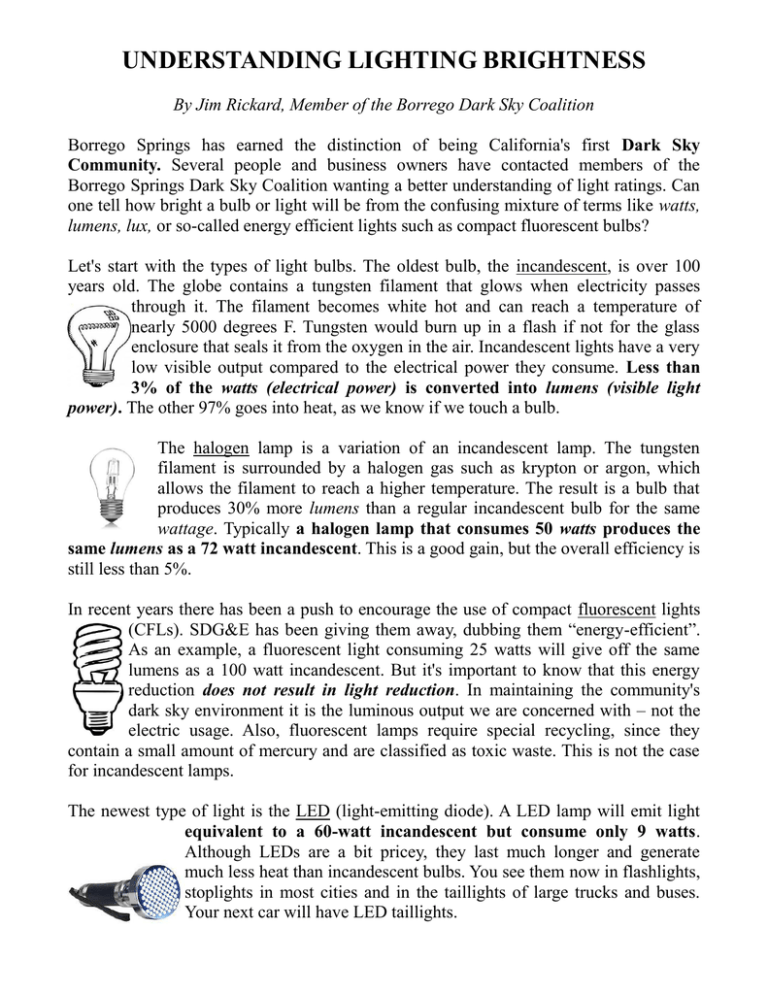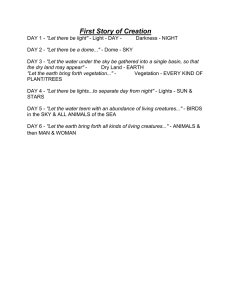UNDERSTANDING LIGHTING BRIGHTNESS
advertisement

UNDERSTANDING LIGHTING BRIGHTNESS By Jim Rickard, Member of the Borrego Dark Sky Coalition Borrego Springs has earned the distinction of being California's first Dark Sky Community. Several people and business owners have contacted members of the Borrego Springs Dark Sky Coalition wanting a better understanding of light ratings. Can one tell how bright a bulb or light will be from the confusing mixture of terms like watts, lumens, lux, or so-called energy efficient lights such as compact fluorescent bulbs? Let's start with the types of light bulbs. The oldest bulb, the incandescent, is over 100 years old. The globe contains a tungsten filament that glows when electricity passes through it. The filament becomes white hot and can reach a temperature of nearly 5000 degrees F. Tungsten would burn up in a flash if not for the glass enclosure that seals it from the oxygen in the air. Incandescent lights have a very low visible output compared to the electrical power they consume. Less than 3% of the watts (electrical power) is converted into lumens (visible light power). The other 97% goes into heat, as we know if we touch a bulb. The halogen lamp is a variation of an incandescent lamp. The tungsten filament is surrounded by a halogen gas such as krypton or argon, which allows the filament to reach a higher temperature. The result is a bulb that produces 30% more lumens than a regular incandescent bulb for the same wattage. Typically a halogen lamp that consumes 50 watts produces the same lumens as a 72 watt incandescent. This is a good gain, but the overall efficiency is still less than 5%. In recent years there has been a push to encourage the use of compact fluorescent lights (CFLs). SDG&E has been giving them away, dubbing them “energy-efficient”. As an example, a fluorescent light consuming 25 watts will give off the same lumens as a 100 watt incandescent. But it's important to know that this energy reduction does not result in light reduction. In maintaining the community's dark sky environment it is the luminous output we are concerned with – not the electric usage. Also, fluorescent lamps require special recycling, since they contain a small amount of mercury and are classified as toxic waste. This is not the case for incandescent lamps. The newest type of light is the LED (light-emitting diode). A LED lamp will emit light equivalent to a 60-watt incandescent but consume only 9 watts. Although LEDs are a bit pricey, they last much longer and generate much less heat than incandescent bulbs. You see them now in flashlights, stoplights in most cities and in the taillights of large trucks and buses. Your next car will have LED taillights. Bulb labeling Labeling and packaging information on lights can be difficult to understand. The box may say “17 watts CFL, equivalent to 60 watt incandescent, 800 lumens light output”. The 17 watts refers to the electrical consumption for the compact fluorescent lamp. The light output is 800 lumens which is the same as a 60 watt incandescent. Rarely the box may give the output in lumens-per-watt. Here again you are expected to know that a CFL produces about 45 lumens per watt and an incandescent 14 lumens per watt. For architects and builders installing indoor lighting in kitchens and bathrooms the building code specifies the lighting in lux which is lumens-per-square meter. A kitchen light fixture is rated according to the distance between the light and the counter top. Dark Sky-Friendly Lights There are three basic principles for friendly outdoor lighting. 1) Use as few lumens as possible; 2) mount the fixture to direct the light toward the ground; and 3) use timers or proximity switches to activate the lights. Choose lamps that have a total visible light output of 4500 lumens or less. This is equivalent to about four 60-watt (or one 250 watt) incandescent bulbs. That’s a lot of light at night. Our dark adapted eyes see the road very well with car headlights of two 50 watt lamps. Lights for the backyard or other security applications can easily be reduced to fit within the 4500 lumen budget. By comparison the cheap mercury vapor barn light can produce over 8000 lumens, or twice the recommended amount. The fixture or enclosure is of equal importance. A common mistake is attaching the fixture against the flat wall of a building. Half the light goes skyward. If the fixture were rotated 90 degrees and pointed downward the majority of the light would illuminate the side of the building and the ground below. The bulb should be completely shielded to direct the light downward away from the sky, away from your neighbor's house. A person driving or walking by at night should not be able to see the bulb below the bottom of the fixture. Lights that are on when no one is at home may let burglars know the safest time for a break in. Put the lights on a timer, or better still, have the lights on a motion sensor which comes on in response to someone approaching the home. Where to buy Dark Sky light fixtures? Some larger home supply businesses have come on board with Dark Sky light fixtures. Both Lowe’s and Home Depot have displays in their stores, and details on their website. Why a Dark Sky? There has been for many years an awareness of the beautiful night sky we have in Borrego. Urban visitors are stunned by their own lack of seeing the stars and constellations at home. Much of human history has been influenced by mysterious events in the night sky. Of course amateur astronomers and photographers come to Borrego to take advantage of a community without annoying street lights and advertising signs. So the dark sky is a natural beauty worth preserving. A good working definition for a dark sky is being able to see the Milky Way on a moonless night. Another simple test is to find the North Star Polaris and to see the other six stars that make up the Little Dipper (Ursa Minor). It should be pointed out that the sky is never pitch black. There is natural skyglow from starlight and airglow caused by oxygen molecules in the atmosphere excited by the solar wind. We measure the diffuse skyglow in lux. One lux is one lumen per square meter. When there is no moon skyglow illumination is about 1/1000 lux. The airglow drops off as you go up in altitude. This is why astronomers place their observatories on high mountains. The largest natural light that ruins the dark sky is the moon. The full moon is very bright at 1/10 to 2/10s lux. The dark sky is really with us only the two weeks each month between Last Quarter and First Quarter moon phases. The Borrego Springs Dark Sky Coalition can help you determine the output of your outside lighting. If you know the wattage of the bulbs in your lights and the type of light (incandescent, fluorescent, sodium vapor or mercury vapor) we can calculate the lumen output. This is a voluntary service. We are not the light police but we may assist you in choosing the appropriate dark sky friendly lights for preserving the dark sky.


